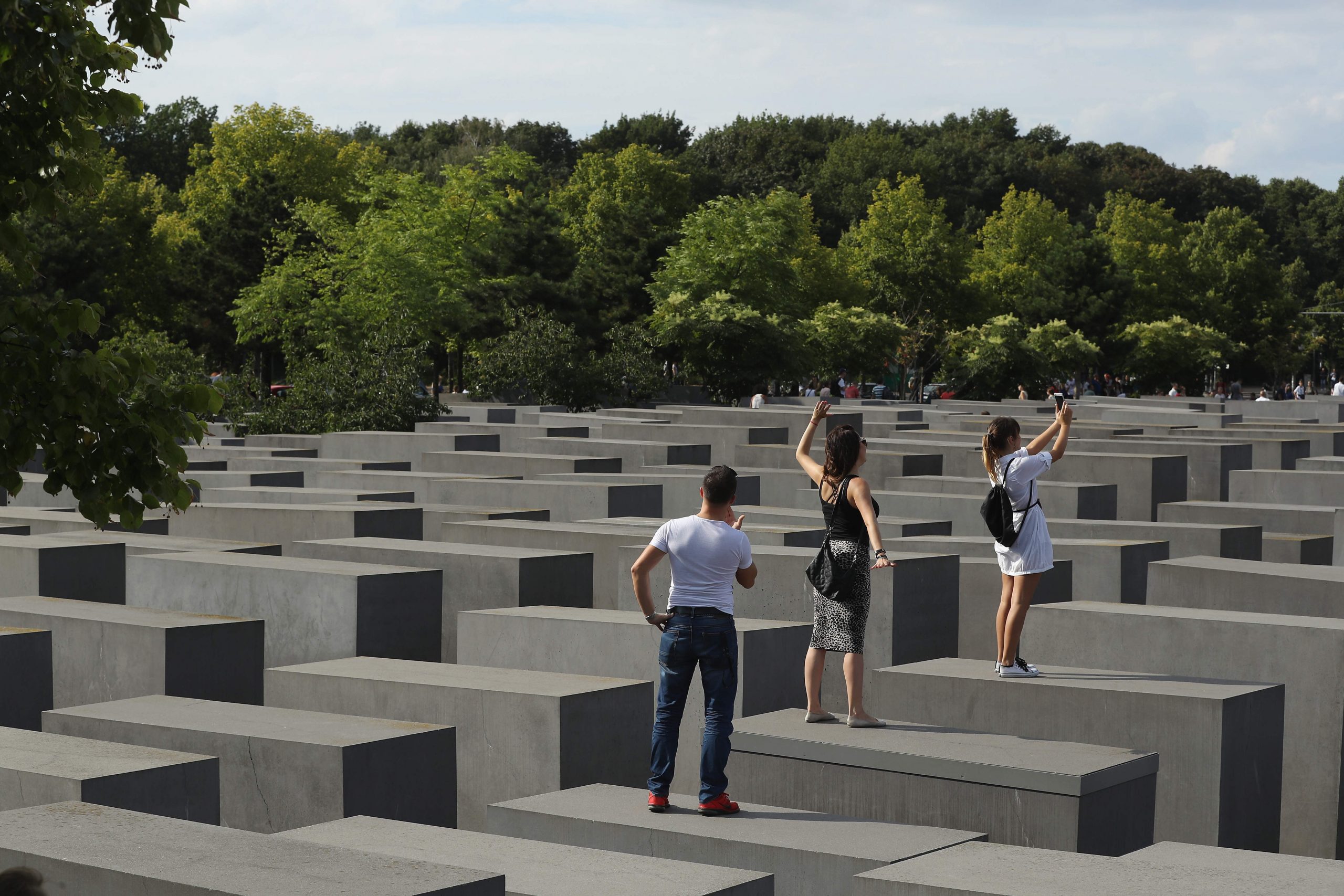
Ten years ago I visited Berlin for the first time. It was a cold and overcast day – the kind of grey that encourages melancholy. When my friends and I came across the city’s Holocaust Memorial, with its maze of over 2,000 concrete slabs, we refrained from taking photos of each other exploring the site. “Might it be disrespectful?” asked one of my non-Jewish (and usually outrageously extroverted) friends. Yes, probably, a bit, we concluded, and moved softly and slowly on through the Memorial’s narrow alleys.
But not all days are gloomy, even in Berlin. And not all visitors to the Memorial had the same reaction as us.
A photo project called “Yolocaust” has collected together images of the Memorial and selfies taken there that young people from around the world have posted to Facebook, Instagram, Tinder and Grindr. In the 12 photos featured on the website, one man juggles pink balls, a girl does yoga atop a pillar, another practises a handstand against a slab’s base. The last of these is tagged “#flexiblegirl #circus #summer”.
Most of the images seem more brainless than abusive. But the implication seems to be that such behaviour risks sliding into insult – a fear all too painfully embodied in the first image of the series: a shot of two guys leaping between pillars with the tag-line: “Jumping on dead Jews @ Holocaust Memorial.”
Grim doesn’t begin to cover it, but the artist who collated the photos has thought up a clever device for retribution. As your cursor scrolls or hovers over each photo, a second image is then revealed beneath. These hidden black-and-white photographs of the Holocaust show countless emaciated bodies laid out in mass graves, or piled up against walls.
Even though they are familiar for those who learned about the Nazi concentration camps at school, these historic scenes are still too terrible and I cannot look at them for more than a few seconds before something in my chest seizes up. In fact, it’s only on second glance that I see the artist has also super-imposed the jumping men into the dead bodies – so that their sickening metaphor “jumping on dead Jews” is now made to appear actual.
The result is a powerful montage, and its message is an important one: that goofy, ill-considered behaviour at such sites is disrespectful, if not worse. Just take the woman who urinated on a British war memorial, or the attack on a Holocaust memorial in Hungary.
But while desecration and hate should not be tolerated anywhere, especially not at memorials, does juggling fall into the same category?
I can’t help but feel that the Yolocaust project is unfair to many of the contemporary subjects featured. After all, this is not Auschwitz but the centre of a modern city. If public-space memorials are intended to be inhabited, then surely they invite use not just as places for contemplation, grieving and reflection but also for being thankful for your life and your city on a sunny day?
The Memorial in Berlin is clearly designed to be walked in and around. Even the architect, Peter Eisenman, has been reported saying he wants visitors to behave freely at the site – with children playing between the pillars and families picnicking on its fringes.
So how do we determine what is offensive behaviour and what is not?
A section at the bottom of the Yolocaust website also suggests (in rather sarcastic tones) that there are no prescriptions on how visitors should behave, “at a site that marks the death of 6 million people”. Though in fact a code of conduct on the memorial’s website lists the following as not permitted: loud noise, jumping from slab to slab, dogs or pets, bicycles, smoking and alcohol.
Only one of Yolocaust’s 12 photos breaks this code: the first and only explicitly insulting image of the jumping men. Another six show people climbing or sitting atop the pillars but most of these are a world away in tone from the jumpers.
The blurb at the bottom of the webpage says that the project intends to explore “our commemorative culture”. But by treating the image of the yoga performer – with an accompanying montage of her balancing amid dead bodies – in the same way as the jumping men, the artist seems to conflate the two.
In fact, the girl practising a yoga balance could be seen as a hopeful – if overtly cutesy and hipster – act of reverence. “Yoga is connection with everything around us,” says her tag beneath. And even if climbing the slabs is frowned upon by some, it could also be read as an act of joy, something to cherish when faced with such a dark history.
In an era when populist German politicians are using the past – and sentiment towards Holocaust memorials themselves – to rev up anti-immigrant, nationalist feeling, the need for careful and inclusive readings of the role of memorials in our society has never been greater.
Yolocaust may have intended to provide a space for reflection on our commemorative behaviour but the result feels worryingly sensationalist, if not censorious. Instead of inviting others in to the act of respectful commemoration, has it risked shutting people out?






